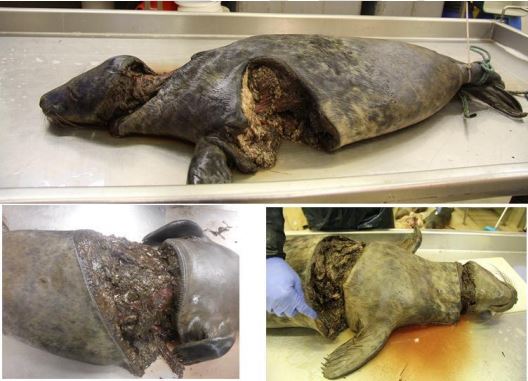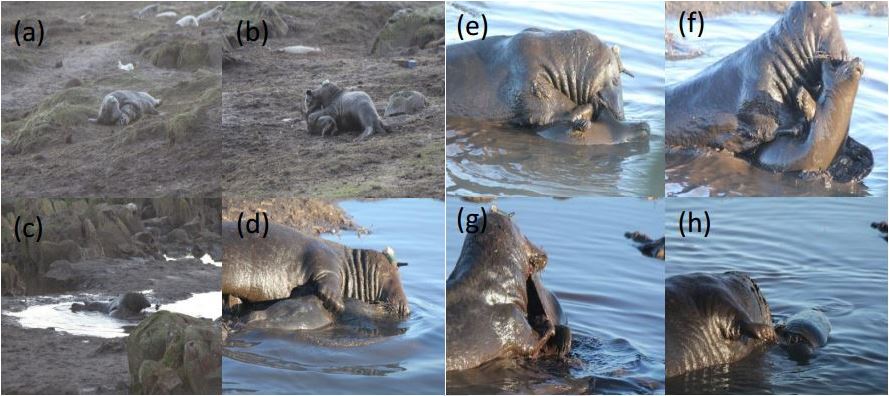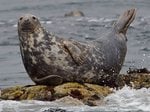The Grey Seals’ corkscrew injuries, which led experts to suspect ship propellers were the cause, are more likely to be the result of cannibalism – the male adults attacking the juveniles, says the Sea Mammal Research Unit (SMRU), part of the UK’s Natural Environment Research Council (NERC) Collaborative Centre.
SMRU researchers say there is strong evidence pointing to the predatory behavior of grey seals, rather than ships’ propellers, as being the cause of the spiral seal deaths, commonly referred to as “corkscrew seals”.
The researchers saw an adult male grey seal kill five seal pups, leaving them with the hallmark corkscrew (spiral seal) injuries. Similar occurrences in Germany suggest such predatory behavior is common and could explain the recent clusters of injured seals found around the coast of Scotland.

Two grey seal pups that were observed being killed and partially eaten by an adult male grey seal. (Photo: SMRU)
While not completely eliminating ship propellers as a possible cause, it is now significantly less likely they are a key factor, the researchers believe.
Richard Lochhead ,Scottish Environment Secretary, said:
“The clusters of ”corkscrew seal” deaths were unusual and worrying. In common with many of the creatures that live in our seas, seals are animals that are loved by the public.”
“It is very important that we understand what caused these unusual deaths and we now have important evidence that natural predatory behaviour is likely to be the main cause, rather than ship propeller injuries as we first thought. This provides some reassurance for the shipping industry.”
“This information will help to inform regulators, developers and others enabling them to take it into account in their activities. Marine Scotland will continue to monitor our seal population for further injuries and any evidence about the causes.”
From 2009 to October 2014, eighty-six seal carcasses were found in Scotland with the unusual corckscrew injuries. Experts could not explain what caused them.
Marine Scotland commissioned the SMRU at St. Andrews University to try to determine what might have caused the injuries.
Until the end of 2014, the investigation was pointing to specific types of ship propellers as the likely culprits. Some scale model tests appeared to confirm this.

This series of photos shows an adult male grey seal capturing a weaned pup, lifting and dragging it to a freshwater pool, forcing it under water, tearing at its flesh, and causing the spiral laceration or ‘corkscrew cut’. (Photo: SMRU)
The SMRU was then funded to tag some of the grey seals in the Firth of Forth to observe how they interacted with passing ships, and if possible, see whether any of them suffered injuries.
Researchers saw an adult male attack grey seal juveniles
The investigators reported finding a number of young grey seals with the hallmark spiral injuries, but surprisingly, these were observed and recorded to have resulted from adult grey seal predation.
In their report (citation below), the researchers wrote:
“On the 2nd December, 2014, an adult male grey seal was seen to approach a weaned grey seal pup. It grabbed the pup by the scruff of the neck and dragged it over 20m to a shallow freshwater pool. The adult then climbed on top of the pup, forced its head under water and held it until its struggle subsided.”
“The male seal then proceeded to bite the back of the neck and simultaneously pull back its head while pushing away with is fore flipper. This caused the skin to tear along a length of approx. 20 cm. and caused the blubber layer along the line to tear to detach from the underlying body musculature.”
The authors continued describing how the adult proceeded to eat the blubber.
Citation: “Preliminary report on predation by adult grey seals on grey seal pups as a possible explanation for corckscrew injury patterns seen in unexplained seal deaths,” Dave Thompson, Joe Onoufriou, Andrew Brownlow & Amy Biship. Sea Mammal Research Unit Report to the Scottish Government.

